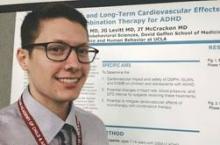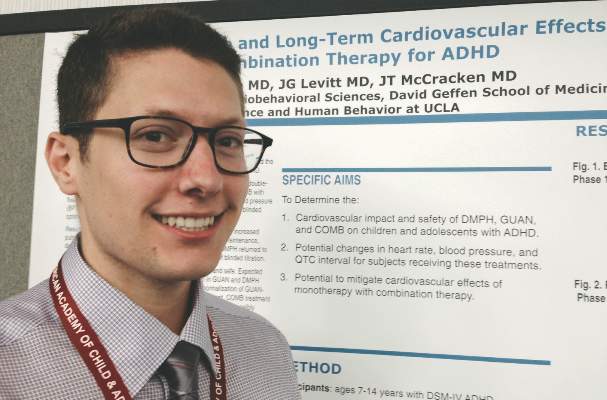User login
SAN DIEGO – Extended-release dexmethylphenidate combined with guanfacine caused no adverse cardiovascular effects among children with attention-deficit/hyperactivity disorder, according to results from a double-blind, randomized trial of 207 patients presented at the annual meeting of the American Academy of Child and Adolescent Psychiatry.
On electrocardiography, a QTc interval prolongation of more than 500 ms raises concerns about arrhythmia and sudden death, “but this study showed that this did not happen with combination treatment,” lead investigator Dr. Gregory Sayer said in an interview. “In fact, there were no clinically meaningful cardiovascular effects.
“The take-home message is that combination therapy with dexmethylphenidate extended release and guanfacine immediate release is a cardiovascularly safe option for patients who might require dual therapy.”
Stimulants for ADHD were previously thought to carry the risk of sudden cardiac death, noted Dr. Sayer, a third-year psychiatry resident at the University of California, Los Angeles. Although further analyses revealed that these concerns were unfounded, clinicians have continued to question the milder cardiovascular effects of stimulants for ADHD, as well as the effects of combining stimulants with alpha-2 agonists such as guanfacine, which can improve cognitive function in ADHD, he said.
Therefore, Dr. Sayer and his associates monitored pulse, blood pressure, and electrocardiograms in children with ADHD who were 7-14 years old and had been randomized in a double-blinded fashion to immediate-release guanfacine (1-3 mg/day), extended-release dexmethylphenidate (5-20 mg/day), or both. They measured vital signs and ECGs at baseline, at the end of the 8-week dose-optimization period, and then monthly during a 12-month, open-label maintenance phase, they reported.
Guanfacine and dexmethylphenidate had “opposing cardiovascular effects,” although none of these effects were clinically significant, the researchers said. During titration, guanfacine monotherapy lowered children’s pulse and blood pressure; dexmethylphenidate increased pulse, blood pressure, and QTc interval; and combination therapy increased diastolic blood pressure alone, they said. “The combination group’s parameters fell between the ranges for both monotherapy groups, and there were no significant QTc changes in the combination therapy group,” Dr. Sayer added.
“Combination treatment may buffer long-term cardiovascular effects of guanfacine and stimulant monotherapy, possibly reducing risk from the small but significant changes resulting from either single treatment,” he and his associates concluded.
During the yearlong maintenance phase, cardiovascular measures remained stable except for a borderline significant increase in pulse in the guanfacine group (P = .06) and a decrease in systolic blood pressure in the dexmethylphenidate group (P < .0001, the researchers reported.
The study is part of a larger trial that is examining the effects of combination therapy on ADHD symptoms and cognitive effects, such as working memory, Dr. Sayer noted. In the current study, the researchers did not continuously monitor vital signs, such as with a Holter monitor, so they could not eliminate the possibility of cardiac phenomena occurring between monitoring points, he added.
The National Institute of Mental Health funded the study. Dr. Sayer declared having no conflicts of interest. Two coauthors reported financial or advisory relationships with Akili Interactive Labs, Sunovion, and other companies.
SAN DIEGO – Extended-release dexmethylphenidate combined with guanfacine caused no adverse cardiovascular effects among children with attention-deficit/hyperactivity disorder, according to results from a double-blind, randomized trial of 207 patients presented at the annual meeting of the American Academy of Child and Adolescent Psychiatry.
On electrocardiography, a QTc interval prolongation of more than 500 ms raises concerns about arrhythmia and sudden death, “but this study showed that this did not happen with combination treatment,” lead investigator Dr. Gregory Sayer said in an interview. “In fact, there were no clinically meaningful cardiovascular effects.
“The take-home message is that combination therapy with dexmethylphenidate extended release and guanfacine immediate release is a cardiovascularly safe option for patients who might require dual therapy.”
Stimulants for ADHD were previously thought to carry the risk of sudden cardiac death, noted Dr. Sayer, a third-year psychiatry resident at the University of California, Los Angeles. Although further analyses revealed that these concerns were unfounded, clinicians have continued to question the milder cardiovascular effects of stimulants for ADHD, as well as the effects of combining stimulants with alpha-2 agonists such as guanfacine, which can improve cognitive function in ADHD, he said.
Therefore, Dr. Sayer and his associates monitored pulse, blood pressure, and electrocardiograms in children with ADHD who were 7-14 years old and had been randomized in a double-blinded fashion to immediate-release guanfacine (1-3 mg/day), extended-release dexmethylphenidate (5-20 mg/day), or both. They measured vital signs and ECGs at baseline, at the end of the 8-week dose-optimization period, and then monthly during a 12-month, open-label maintenance phase, they reported.
Guanfacine and dexmethylphenidate had “opposing cardiovascular effects,” although none of these effects were clinically significant, the researchers said. During titration, guanfacine monotherapy lowered children’s pulse and blood pressure; dexmethylphenidate increased pulse, blood pressure, and QTc interval; and combination therapy increased diastolic blood pressure alone, they said. “The combination group’s parameters fell between the ranges for both monotherapy groups, and there were no significant QTc changes in the combination therapy group,” Dr. Sayer added.
“Combination treatment may buffer long-term cardiovascular effects of guanfacine and stimulant monotherapy, possibly reducing risk from the small but significant changes resulting from either single treatment,” he and his associates concluded.
During the yearlong maintenance phase, cardiovascular measures remained stable except for a borderline significant increase in pulse in the guanfacine group (P = .06) and a decrease in systolic blood pressure in the dexmethylphenidate group (P < .0001, the researchers reported.
The study is part of a larger trial that is examining the effects of combination therapy on ADHD symptoms and cognitive effects, such as working memory, Dr. Sayer noted. In the current study, the researchers did not continuously monitor vital signs, such as with a Holter monitor, so they could not eliminate the possibility of cardiac phenomena occurring between monitoring points, he added.
The National Institute of Mental Health funded the study. Dr. Sayer declared having no conflicts of interest. Two coauthors reported financial or advisory relationships with Akili Interactive Labs, Sunovion, and other companies.
SAN DIEGO – Extended-release dexmethylphenidate combined with guanfacine caused no adverse cardiovascular effects among children with attention-deficit/hyperactivity disorder, according to results from a double-blind, randomized trial of 207 patients presented at the annual meeting of the American Academy of Child and Adolescent Psychiatry.
On electrocardiography, a QTc interval prolongation of more than 500 ms raises concerns about arrhythmia and sudden death, “but this study showed that this did not happen with combination treatment,” lead investigator Dr. Gregory Sayer said in an interview. “In fact, there were no clinically meaningful cardiovascular effects.
“The take-home message is that combination therapy with dexmethylphenidate extended release and guanfacine immediate release is a cardiovascularly safe option for patients who might require dual therapy.”
Stimulants for ADHD were previously thought to carry the risk of sudden cardiac death, noted Dr. Sayer, a third-year psychiatry resident at the University of California, Los Angeles. Although further analyses revealed that these concerns were unfounded, clinicians have continued to question the milder cardiovascular effects of stimulants for ADHD, as well as the effects of combining stimulants with alpha-2 agonists such as guanfacine, which can improve cognitive function in ADHD, he said.
Therefore, Dr. Sayer and his associates monitored pulse, blood pressure, and electrocardiograms in children with ADHD who were 7-14 years old and had been randomized in a double-blinded fashion to immediate-release guanfacine (1-3 mg/day), extended-release dexmethylphenidate (5-20 mg/day), or both. They measured vital signs and ECGs at baseline, at the end of the 8-week dose-optimization period, and then monthly during a 12-month, open-label maintenance phase, they reported.
Guanfacine and dexmethylphenidate had “opposing cardiovascular effects,” although none of these effects were clinically significant, the researchers said. During titration, guanfacine monotherapy lowered children’s pulse and blood pressure; dexmethylphenidate increased pulse, blood pressure, and QTc interval; and combination therapy increased diastolic blood pressure alone, they said. “The combination group’s parameters fell between the ranges for both monotherapy groups, and there were no significant QTc changes in the combination therapy group,” Dr. Sayer added.
“Combination treatment may buffer long-term cardiovascular effects of guanfacine and stimulant monotherapy, possibly reducing risk from the small but significant changes resulting from either single treatment,” he and his associates concluded.
During the yearlong maintenance phase, cardiovascular measures remained stable except for a borderline significant increase in pulse in the guanfacine group (P = .06) and a decrease in systolic blood pressure in the dexmethylphenidate group (P < .0001, the researchers reported.
The study is part of a larger trial that is examining the effects of combination therapy on ADHD symptoms and cognitive effects, such as working memory, Dr. Sayer noted. In the current study, the researchers did not continuously monitor vital signs, such as with a Holter monitor, so they could not eliminate the possibility of cardiac phenomena occurring between monitoring points, he added.
The National Institute of Mental Health funded the study. Dr. Sayer declared having no conflicts of interest. Two coauthors reported financial or advisory relationships with Akili Interactive Labs, Sunovion, and other companies.
Key clinical point: Combination therapy with dexmethylphenidate extended release and guanfacine immediate release is a cardiovascularly safe option for patients who might require dual therapy.
Major finding: There were no clinically meaningful cardiovascular changes in any treatment group during the acute titration and maintenance phases.
Data source: Double-blind, randomized, parallel-group, fixed-flexible dosing study with 12-month open-label follow-up of 207 children and adolescents with ADHD.
Disclosures: The National Institute of Mental Health funded the study. Dr. Sayer declared having no conflicts of interest. Two coauthors reported financial or advisory relationships with Akili Interactive Labs, Sunovion, and other companies.

